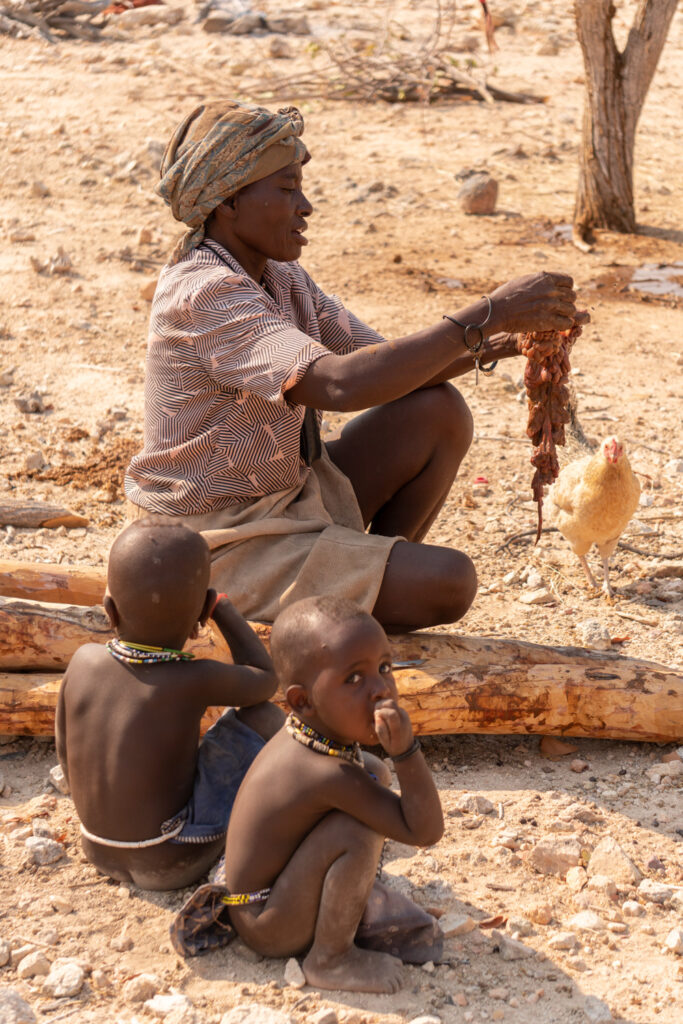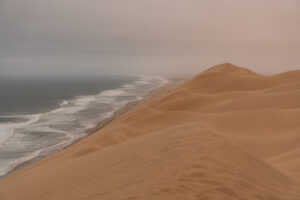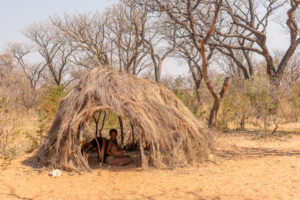« From 6th to 11th of September 2022 »
Toward Angola border
We ‘re heading to the north of Namibia, near Angola border. We arrive in Opuwo, the last « big » town of the region.
In a desert environment, where the dust flies with the wind, we discover a decor of far west revisited. The city is a mixture of precarious tin and concrete buildings. Rusty carcasses of cars are next to the 4X4, shining in the sun, of the most well-to-do or tourists. In the hypercenter, two supermarkets face each other, Spar and OK food. We know that this is where we have to stock up on food because we won’t find any supermarkets in the next few days.


Opuwo is also a melting pot in terms of population. City dwellers, Herero and Himba tribes. The Himbas are the image that we have through the TV show “Encounter in unknown land”. Their culture is still very much preserved. Until 1992, a special permit was required to enter and leave the Koakoland region, where the Himba lived. The purpose of this law was to protect the economy of the white farmers and to prevent the Himba cattle from competing with the settlers.


Himba women are known for their headdress. They have long hair in dread lock and coated with red clay just like their body. The paste is made from red rock powder and animal fat. While the interest is aesthetic for their hair, this coating protects their skin from the sun. They wear many jewels at the wrists, at the ankles and around the nape of the neck, above their bare chest. We come across several of them, true to this description, in the supermarket aisles. The clash of cultures between the “modern” world of overconsumption and these women in their traditional clothes reminds us of the film An Indian in the City. However, in Opuwo, now that Westernization has invited itself into the midst of the tribes, this is part of everyday life.



On the road to Epupa
180 kilometers separate the falls of Epupa from Opuwo. We are subjugated by the landscapes which vary during the road. Sometimes the desert gives way to an oasis of greenery. The road crosses a green concentration of palm trees, and leafy trees in any kind. Sometimes the desert takes a third dimension with hills and rocky heaps that frame the road. On the horizon, beautiful mountains covered with shrubs draw harmonious curves between sky and earth.




As we approach Epupa, the beauty of the hilly road finally makes us forget the repeated jolts of the striated road. This region reminds us a lot of Turkana in Kenya (see Article 16 Turkana, the biggest alkaline lake in the world and its tribes). The tribes live in a remote place with difficult conditions. At the end of a dry track, there is an oasis; here the river Kunene and in Kenya, the lake Turkana.



The Himba are nomads and it is not rare that we find abandoned or unoccupied villages. We take a small road on the left which passes not far from Himba villages. We cross again beautiful landscapes on a small dirt road. We finally arrive in a desert. There is no more dwelling and a flat ground to welcome us in the middle of the rocky mountains. It is here that we will sleep this evening.




Small cultural point
The next few days, we have the chance to meet some nice people. In particular Pius, who is our age and speaks very good English. In addition to telling us more about the Himba culture, he teaches us some words to be able to greet the locals:
- Okuhepa = Thanks
- Moro = Good morning
- Metar = Good afternoon
- Kwenda = Good evening
- Kili vi ? = How are you?
- Kili nawa ? = I’m fine
- Ewa = Yes
- Ove Oune ? = What is your name?
Pius is our interpreter to exchange with the people of his district and better understand their way of life. On our side, we tell our journey by the road since almost 1 year.




The wedding
Himba marriage and love relationships are very different from ours:
- Only the marriage give right to a father to be recognized as responsible for his children.
- A man can marry as many times as his money allows. It is common to have 3 wives. The first marriage must be to a girl. Thus she becomes the promised wife. When she reaches puberty, she is considered a woman. She then leaves her family to live with her husband. In the meantime, one often marries a second woman who is already an adult. Thus, a man will often marry twice in order to marry the adult woman of his choice.
- Marriage is commonly done within the family because it is difficult to convince the parents of a girl from another village. For example, a girl I met at school in Opuwo.
- Outside of marriage, it is common to have a girlfriend even if she is married. Among the Himba, it is possible to have relationships and children outside of marriage. But the father will not be recognized. Leaving the village for too long may allow others to seduce his wife or girlfriend who remains in waiting.





Lifestyle
The Himba live from cattle, like the Maasai. They graze their herds, and take them wherever they can find some greenery. In the past, they also hunted, but this practice is now illegal without a permit. Parents choose which children to send to school and which children to train to look after the goats.




Uyo makes its movie show
We are installed not far from a village and at the end of the day, three young children come to meet us. One of them has already seen us at school and brought his friends. They are curious and want to discover our van. After a small presentation, he shows us the phone and asks us if we have videos. We then propose them to watch a film. On the three proposed films, they choose the first episode of the series “Our Planet” which presents several animal species coming from the 4 corners of the world. Who says film says popcorn. Valentin’s stomach is rumbling. As soon as the movie starts, he starts to prepare the famous popcorn. In no time, the pan is filled. The kids are thrilled!
At the very end, Pius joins us. He is a little disappointed to have missed the film and asks us if we have another one to propose. We know that he likes the soccer so our choice settles on “Pelé, birth of a Legend”. We move the table to move away from our shower space. While the film starts, we take turns to wash ourselves, out of sight. After a so hot day, that makes us the biggest good.


Water is scarce in this arid region so we only consume 1.5L each per shower. The equivalent of a big bottle in which we have drilled holes on the cap. The dry season starts in July-August, keeping a certain coolness. From September, the temperatures rise until December and trigger the first rains. The rains are less intense than in the past. Access to water becomes more difficult in the dry season. For example, the first well of the school is already exhausted. Now we have to dig very deep to have water all year round.
As the film progresses, several children come closer. They look at us from afar, hoping to hear bits of the film or see some images. We decide to change our set-up to allow this small group to join us. Most of them sit on the floor, a few on our seats and one on Laurène’s knee. Not all of them speak English but they enjoy the movie. The soccer passages (quite recurrent) are the most successful. First a few smiles, then they let themselves laugh heartily.
Kunene river and Epupa falla
Nous continuons notre route en passant par les chutes d’Epupa et la rivière Kunene qui sépare la Namibie de l’Angola.






The D3700 road along the Kunene River is one of the most scenic roads we had the chance to drive. The hills follow each other, giving a new viewpoint every time. A few easy 4×4 passages make it more exciting. We take the time to stop on the road to bivouac and enjoy the freshness of the water. Every evening, our ephemeral garden is magnificent. But beware of crocodiles!








One evening, we set up camp by the river. We were starting the aperitif, when a family passed by our camp. The man was coming to put fishing nets in the river. We invited them to join us to share a beer together. This evening for two turned into an improbable moment of exchange and sharing. This is what we like in this trip: beautiful and unexpected meetings.





